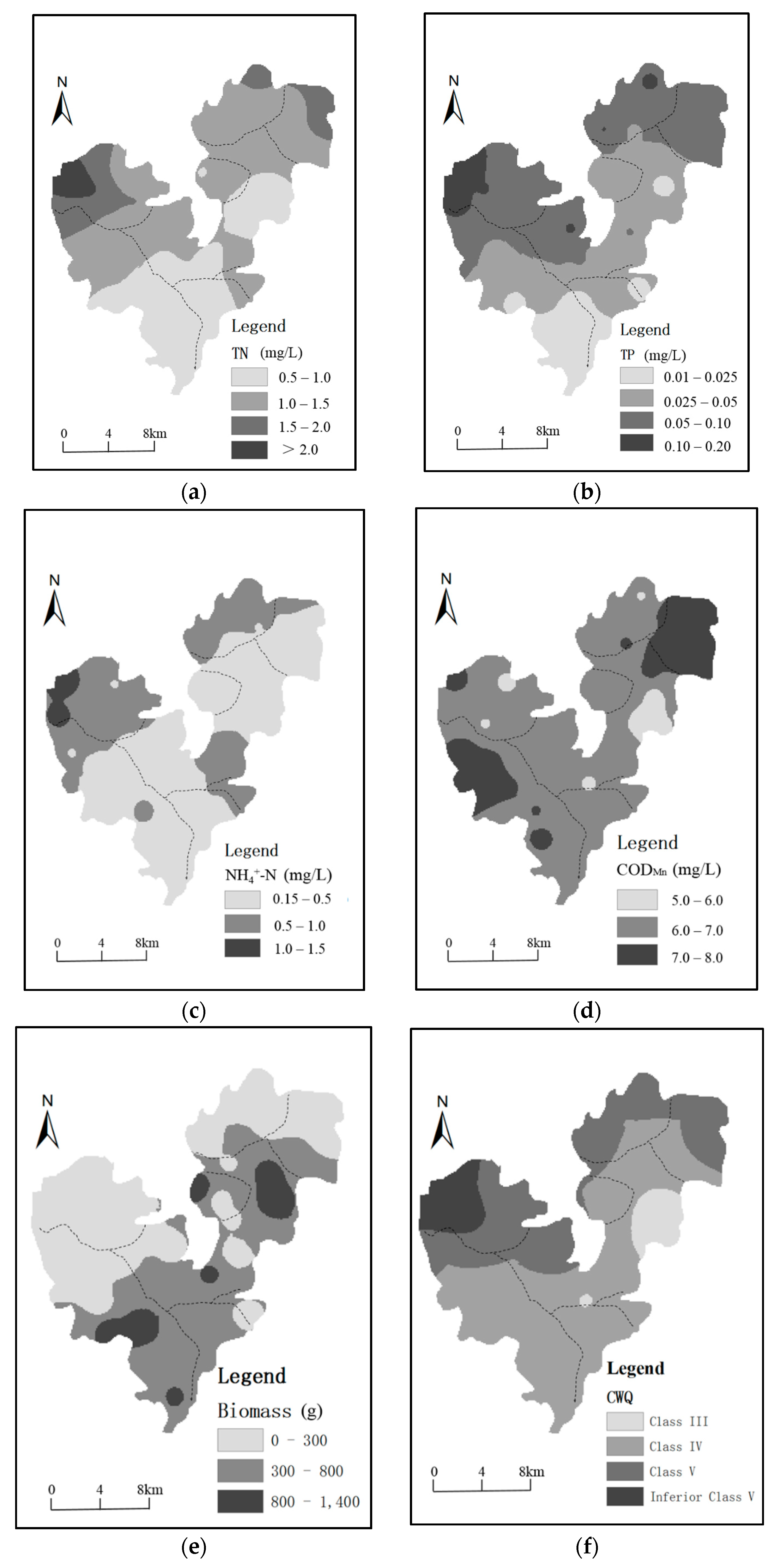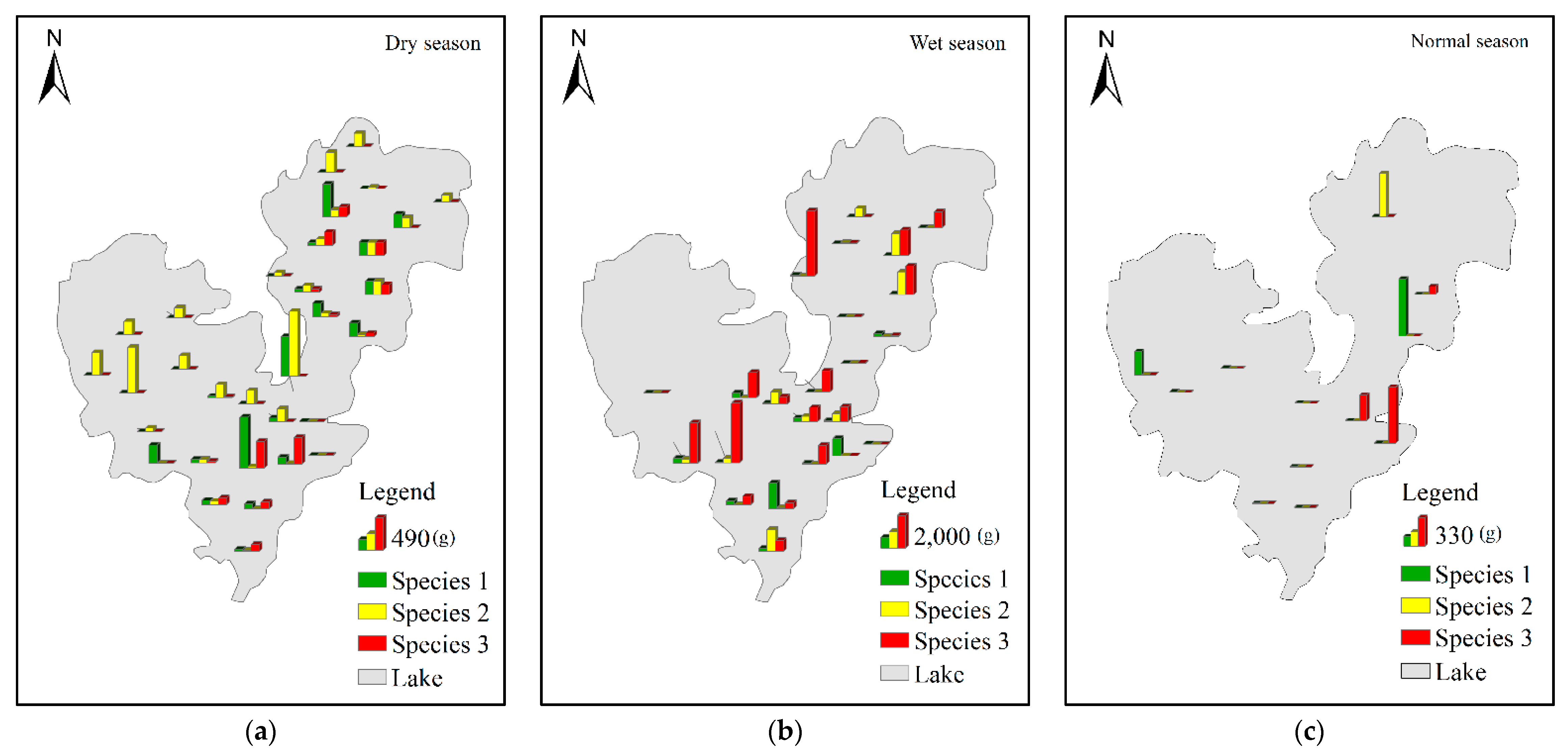Exploring the Spatial-Seasonal Dynamics of Water Quality, Submerged Aquatic Plants and Their Influencing Factors in Different Areas of a Lake
Abstract
:1. Introduction
2. Materials and Methods
2.1. Study Area
2.2. Data and Methods
2.2.1. Data Collection
2.2.2. Data Preprocessing
2.2.3. Methods
3. Results
3.1. Seasonal Variation in Water Quality and Submerged Aquatic Plant Biomass
3.2. Spatial Dynamics of Water Quality Parameters and Submerged Aquatic Plant Biomass
3.3. Preliminary Identification of Influencing Factors of Water Quality and Submerged Aquatic Plant Biomass Using PCA
3.4. Correlations between Water Quality Parameters and Submerged Aquatic Plant Biomass
4. Discussion
4.1. The Close Relationship between Lake Water Quality and Land Use/Economic Development in Surrounding Areas
4.1.1. Influences of Agricultural and Social Development on Water Quality
4.1.2. Influences of Aquaculture Development on Water Quality
4.2. Influencing Factors of the Growth of Submerged Aquatic Plants in Different Seasons
4.3. Implications for Future Water Quality Management in Honghu Lake
5. Conclusions
Supplementary Materials
Acknowledgments
Author Contributions
Conflicts of Interest
Appendix A
| Parameters | Environmental Guidelines | |||||
|---|---|---|---|---|---|---|
| Class I | Class II | Class III | Class IV | Class V | ||
| pH | 6–9 | |||||
| Transparency (m) | - | |||||
| DO (mg/L) | >7.5 | 6 | 5 | 3 | 2 | |
| NH4+–N (mg/L) | <0.15 | 0.5 | 1.0 | 1.5 | 2.0 | |
| TN (mg/L) | <0.2 | 0.5 | 1.0 | 1.5 | 2.0 | |
| TP (mg/L) | <0.01 | 0.025 | 0.05 | 0.1 | 0.2 | |
| CODMn (mg/L) | <2 | 4 | 5 | 10 | 15 | |
| Biomass (g) | - | |||||
References
- Mouri, G.; Takizawa, S.; Oki, T. Spatial and temporal variation in nutrient parameters in stream water in a rural-urban catchment, Shikoku, Japan: Effects of land cover and human impact. J. Environ. Manag. 2011, 92, 1837–1848. [Google Scholar] [CrossRef] [PubMed]
- Zhu, M.; Zhu, G.; Zhao, L.; Yao, X.; Zhang, Y.; Gao, G.; Qin, B. Influence of algal bloom degradation on nutrient release at the sediment—Water interface in Lake Taihu, China. Environ. Sci. Pollut. Res. 2013, 20, 1803–1811. [Google Scholar] [CrossRef] [PubMed]
- Mainstone, C.P.; Parr, W. Phosphorus in rivers-ecology and management. Sci. Total Environ. 2002, 282, 25–47. [Google Scholar] [CrossRef]
- Poquet, J.M.; Mezquita, F.; Rueda, J.; Miracle, M.R. Loss of Ostracoda biodiversity in Western Mediterranean wetlands. Aquat. Conserv. Mar. Freshw. Ecosyst. 2008, 18, 280–296. [Google Scholar] [CrossRef]
- Le, C.; Zha, Y.; Li, Y.; Sun, D.; Lu, H.; Yin, B. Eutrophication of lake waters in China: Cost, causes, and control. Environ. Manag. 2010, 45, 662–668. [Google Scholar] [CrossRef] [PubMed]
- Wang, M.; Shi, W.; Tang, J. Water property monitoring and assessment for China’s inland Lake Taihu from MODIS-Aqua measurements. Remote Sens. Environ. 2011, 115, 841–854. [Google Scholar] [CrossRef]
- Liu, W.; Zhang, Q.; Liu, G. Lake eutrophication associated with geographic location, lake morphology and climate in China. Hydrobiologia 2010, 644, 289–299. [Google Scholar] [CrossRef]
- Chang, B.; Li, R.; Zhu, C.; Liu, K. Quantitative impacts of climate change and human activities on water-surface area variations from the 1990s to 2013 in Honghu Lake, China. Water 2015, 7, 2881–2899. [Google Scholar] [CrossRef]
- Nyairo, W.N.; Owuor, P.O.; Kengara, F.O. Effect of anthropogenic activities on the water quality of Amala and Nyangores tributaries of River Mara in Kenya. Environ. Monit. Assess. 2015, 187, 691. [Google Scholar] [CrossRef] [PubMed]
- Fatema, K.; Maznah, W.W.; Isa, M. Spatial variation of water quality parameters in a mangrove estuary. Int. J. Environ. Sci. Technol. 2015, 12, 2091–2102. [Google Scholar] [CrossRef]
- Shang, G.; Shang, J. Spatial and temporal variations of eutrophication in Western Chaohu Lake, China. Environ. Monit. Assess. 2007, 130, 99–109. [Google Scholar] [CrossRef] [PubMed]
- Lacoul, P.; Freedman, B. Environmental influences on aquatic plants in freshwater ecosystems. Environ. Rev. 2006, 14, 89–136. [Google Scholar] [CrossRef]
- Lewis, W.M.; Wurtsbaugh, W.A. Control of lacustrine phytoplankton by nutrients: Erosion of the phosphorus paradigm. Int. Rev. Hydrobiol. 2008, 93, 446–465. [Google Scholar] [CrossRef]
- Kurunc, A.; Ersahin, S.; Sonmez, N.K.; Kaman, H.; Uz, I.; Uz, B.Y.; Aslan, G.E. Seasonal changes of spatial variation of some groundwater quality variables in a large irrigated coastal Mediterranean region of Turkey. Sci. Total Environ. 2016, 554, 53–63. [Google Scholar] [CrossRef] [PubMed]
- Ionita, M.; Lohmann, G.; Rimbu, N.; Chelcea, S.; Dima, M. Interannual to decadal summer drought variability over Europe and its relationship to global sea surface temperature. Clim. Dyn. 2012, 38, 363–377. [Google Scholar] [CrossRef]
- Lehner, B.; Döll, P. Development and validation of a global database of lakes, reservoirs and wetlands. J. Hydrol. 2004, 296, 1–22. [Google Scholar] [CrossRef]
- Borics, G.; Nagy, L.; Miron, S.; Grigorszky, I.; László-Nagy, Z.; Lukács, B.A.; László, G.; Várbíró, G. Which factors affect phytoplankton biomass in shallow eutrophic lakes? Hydrobiologia 2013, 714, 93–104. [Google Scholar] [CrossRef] [Green Version]
- Hampton, S.E.; Izmest, E.; Lyubov, R.; Moore, M.V.; Katz, S.L.; Dennis, B.; Silow, E.A. Sixty years of environmental change in the world’s largest freshwater lake–Lake Baikal, Siberia. Glob. Chang. Biol. 2008, 14, 1947–1958. [Google Scholar] [CrossRef]
- Drevnick, P.E.; Engstrom, D.R.; Driscoll, C.T.; Swain, E.B.; Balogh, S.J.; Kamman, N.C.; Long, D.T.; Muir, D.G.; Parsons, M.J.; Rolfhus, K.R. Spatial and temporal patterns of mercury accumulation in lacustrine sediments across the Laurentian Great Lakes region. Environ. Pollut. 2012, 161, 252–260. [Google Scholar] [CrossRef] [PubMed]
- Tsugeki, N.K.; Urabe, J.; Hayami, Y.; Kuwae, M.; Nakanishi, M. Phytoplankton dynamics in Lake Biwa during the 20th century: Complex responses to climate variation and changes in nutrient status. J. Paleolimnol. 2010, 44, 69–83. [Google Scholar] [CrossRef]
- Zhang, X.; Liu, M. Assessing the spatial and temporal patterns of seasonal precipitation extremes and the potential influencing factors in Dongting Lake basin, China. Water 2016, 8, 558. [Google Scholar] [CrossRef]
- Chen, Y.; Zhao, K.; Wu, Y.; Gao, S.; Cao, W.; Bo, Y.; Shang, Z.; Wu, J.; Zhou, F. Spatio-Temporal Patterns and Source Identification of Water Pollution in Lake Taihu (China). Water 2016, 8, 86. [Google Scholar] [CrossRef]
- Liu, W.; Yu, H.L.; Chung, C. Assessment of water quality in a subtropical alpine lake using multivariate statistical techniques and geostatistical mapping: A case study. Int. J. Environ. Res. Public Health 2011, 8, 1126–1140. [Google Scholar] [CrossRef] [PubMed]
- Shen, P.; Shi, Q.; Hua, Z.; Kong, F.; Wang, Z.; Zhuang, S.; Chen, D. Analysis of microcystins in cyanobacteria blooms and surface water samples from Meiliang Bay, Taihu Lake, China. Environ. Int. 2003, 29, 641–647. [Google Scholar] [CrossRef]
- Chen, Y.; Qin, B.; Teubner, K.; Dokulil, M.T. Long-term dynamics of phytoplankton assemblages: Microcystis-domination in Lake Taihu, a large shallow lake in China. J. Plankton Res. 2003, 25, 445–453. [Google Scholar] [CrossRef]
- Pla, S.; Paterson, A.M.; Smol, J.P.; Clark, B.J.; Ingram, R. Spatial variability in water quality and surface sediment diatom assemblages in a complex lake basin: Lake of the Woods, Ontario, Canada. J. Gt. Lakes Res. 2005, 31, 253–266. [Google Scholar] [CrossRef]
- Malik, R.N.; Nadeem, M. Spatial and temporal characterization of trace elements and nutrients in the Rawal Lake Reservoir, Pakistan using multivariate analysis techniques. Environ. Geochem. Health 2011, 33, 525–541. [Google Scholar] [CrossRef] [PubMed]
- Hu, L.; Hu, W.; Zhai, S.; Wu, H. Effects on water quality following water transfer in Lake Taihu, China. Ecol. Eng. 2010, 36, 471–481. [Google Scholar] [CrossRef]
- Razmkhah, H.; Abrishamchi, A.; Torkian, A. Evaluation of spatial and temporal variation in water quality by pattern recognition techniques: A case study on Jajrood River (Tehran, Iran). J. Environ. Manag. 2010, 91, 852–860. [Google Scholar] [CrossRef] [PubMed]
- Li, T.; Cai, S.; Yang, H.; Wang, X.; Wu, S.; Ren, X. Fuzzy comprehensive-quantifying assessment in analysis of water quality: A case study in Lake Honghu, China. Environ. Eng. Sci. 2009, 26, 451–458. [Google Scholar] [CrossRef]
- Zhang, T.; Ban, X.; Wang, X.; Cai, X.; Li, E.; Wang, Z.; Yang, C.; Zhang, Q.; Lu, X. Analysis of nutrient transport and ecological response in Honghu Lake, China by using a mathematical model. Sci. Total Environ. 2017, 575, 418–428. [Google Scholar] [CrossRef] [PubMed]
- Wang, X.; Li, E.; Yu, J.; Deng, F. Aquatic vegetation landscape anisotropy and its dynamic change of Honghu Lake in response to ecological restoration. Wetl. Sci. 2010, 8, 105–109. (In Chinese) [Google Scholar]
- Meng, Q.; Liu, Z.; Borders, B.E. Assessment of regression kriging for spatial interpolation-comparisons of seven GIS interpolation methods. Cartogr. Geogr. Inf. Sci. 2013, 40, 28–39. [Google Scholar] [CrossRef]
- Murphy, R.R.; Curriero, F.C.; Ball, W.P. Comparison of spatial interpolation methods for water quality evaluation in the Chesapeake Bay. J. Environ. Eng. 2009, 136, 160–171. [Google Scholar] [CrossRef]
- Chen, T.; Ren, L.; Yuan, F.; Yang, X.; Jiang, S.; Tang, T.; Liu, Y.; Zhao, C.; Zhang, L. Comparison of Spatial Interpolation Schemes for Rainfall Data and Application in Hydrological Modeling. Water 2017, 9, 342. [Google Scholar] [CrossRef]
- Berhanu, B.; Seleshi, Y.; Demisse, S.S.; Melesse, A.M. Flow regime classification and hydrological characterization: A case study of Ethiopian Rivers. Water 2015, 7, 3149–3165. [Google Scholar] [CrossRef]
- Huang, F.; Wang, X.; Lou, L.; Zhou, Z.; Wu, J. Spatial variation and source apportionment of water pollution in Qiantang River (China) using statistical techniques. Water Res. 2010, 44, 1562–1572. [Google Scholar] [CrossRef] [PubMed]
- Wilbers, G.J.; Becker, M.; Nga, L.T.; Sebesvari, Z.; Renaud, F.G. Spatial and temporal variability of surface water pollution in the Mekong Delta, Vietnam. Sci. Total Environ. 2014, 485, 653–665. [Google Scholar] [CrossRef] [PubMed]
- Dykoski, C.A.; Edwards, R.L.; Cheng, H.; Yuan, D.; Cai, Y.; Zhang, M.; Lin, Y.; Qing, J.; An, Z.; Revenaugh, J. A high-resolution, absolute-dated Holocene and deglacial Asian monsoon record from Dongge Cave, China. Earth Planet. Sci. Lett. 2005, 233, 71–86. [Google Scholar] [CrossRef]
- Lee, S.; Hwang, S.; Lee, S.; Hwang, H.; Sung, H. Landscape ecological approach to the relationships of land use patterns in watersheds to water quality characteristics. Landsc. Urban Plan. 2009, 92, 80–89. [Google Scholar] [CrossRef]
- Zhao, W.; Zhu, X.; Sun, X.; Shu, Y.; Li, Y. Water quality changes in response to urban expansion: Spatially varying relations and determinants. Environ. Sci. Pollut. Res. 2015, 22, 16997–17011. [Google Scholar] [CrossRef] [PubMed]
- Wu, Y.; Chen, J. Investigating the effects of point source and nonpoint source pollution on the water quality of the East River (Dongjiang) in South China. Ecol. Indic. 2013, 32, 294–304. [Google Scholar] [CrossRef]
- Statistical Yearbooks of Jingzhou City 2013. Available online: http://www.stats-hb.gov.cn/upload/nj/jz2013.pdf (accessed on 14 September 2017).
- Van Drecht, G.; Bouwman, A.; Harrison, J.; Knoop, J. Global nitrogen and phosphate in urban wastewater for the period 1970 to 2050. Glob. Biogeochem. Cycles 2009, 23, 73. [Google Scholar] [CrossRef]
- Gui, F.; Yu, G. Numerical simulations of nutrient transport changes in Honghu Lake Basin, Jianghan Plain. Chin. Sci. Bull. 2008, 53, 2353–2363. [Google Scholar] [CrossRef]
- Routh, J.; Choudhary, P.; Meyers, P.A.; Kumar, B. A sediment record of recent nutrient loading and trophic state change in Lake Norrviken, Sweden. J. Paleolimnol. 2009, 42, 325–341. [Google Scholar] [CrossRef]
- Arhonditsis, G.; Brett, M.; Frodge, J. Environmental control and limnological impacts of a large recurrent spring bloom in Lake Washington, USA. Environ. Manag. 2003, 31, 603–618. [Google Scholar] [CrossRef] [PubMed]
- Demars, B.O.; Edwards, A. Tissue nutrient concentrations in freshwater aquatic macrophytes: High inter-taxon differences and low phenotypic response to nutrient supply. Freshw. Biol. 2007, 52, 2073–2086. [Google Scholar] [CrossRef]
- Sondergaard, M.; Lauridsen, T.L.; Johansson, L.S.; Jeppesen, E. Nitrogen or phosphorus limitation in lakes and its impact on phytoplankton biomass and submerged macrophyte cover. Hydrobiologia 2017, 795, 35–48. [Google Scholar] [CrossRef]
- Zeng, L.; He, F.; Zhang, Y.; Liu, B.; Dai, Z.; Zhou, Q.; Wu, Z. How submerged macrophyte restoration promotes a shift of phytoplankton community in a shallow subtropical lake. Pol. J. Environ. Stud. 2017, 26, 1363–1373. [Google Scholar] [CrossRef]
- Dai, Y.; Jia, C.; Liang, W.; Hu, S.; Wu, Z. Effects of the submerged macrophyte ceratophyllum demersum l. On restoration of a eutrophic waterbody and its optimal coverage. Ecol. Eng. 2012, 40, 113–116. [Google Scholar] [CrossRef]
- Jones, J.I.; Young, J.O.; Eaton, J.W.; Moss, B. The influence of nutrient loading, dissolved inorganic carbon and higher trophic levels on the interaction between submerged plants and periphyton. J. Ecol. 2002, 90, 12–24. [Google Scholar] [CrossRef]
- Pettit, N.E.; Ward, D.P.; Adame, M.F.; Valdez, D.; Bunn, S.E. Influence of aquatic plant architecture on epiphyte biomass on a tropical river floodplain. Aquat. Bot. 2016, 129, 35–43. [Google Scholar] [CrossRef]
- Olsen, S.; Chan, F.; Li, W.; Zhao, S.; Sondergaard, M.; Jeppesen, E. Strong impact of nitrogen loading on submerged macrophytes and algae: A long-term mesocosm experiment in a shallow Chinese lake. Freshw. Biol. 2015, 60, 1525–1536. [Google Scholar] [CrossRef]
- Xu, Y.; Shao, M.; Cao, M.; Zhou, S.; Cai, Q. Using temporal coherence to determine the responses of water clarity to hydrological processes in a giant subtropical canyon-shaped reservoir (China). Quat. Int. 2010, 226, 151–159. [Google Scholar] [CrossRef]
- Paerl, H.W.; Hall, N.S.; Calandrino, E.S. Controlling harmful cyanobacterial blooms in a world experiencing anthropogenic and climatic-induced change. Sci. Total Environ. 2011, 409, 1739–1745. [Google Scholar] [CrossRef] [PubMed]
- Vézie, C.; Rapala, J.; Vaitomaa, J.; Seitsonen, J.; Sivonen, K. Effect of nitrogen and phosphorus on growth of toxic and nontoxic microcystis strains and on intracellular microcystin concentrations. Microb. Ecol. 2002, 43, 443–454. [Google Scholar] [CrossRef] [PubMed]
- Peng, K.; Luo, C.; Lou, L.; Li, X.; Shen, Z. Bioaccumulation of heavy metals by the aquatic plants potamogeton pectinatus L. and potamogeton malaianus Miq. and their potential use for contamination indicators and in wastewater treatment. Sci. Total Environ. 2008, 392, 22–29. [Google Scholar] [CrossRef] [PubMed]
- Bauer, N.; Blaschke, U.; Beutler, E.; Gross, E.; Jenett-Siems, K.; Siems, K.; Hilt, S. Seasonal and interannual dynamics of polyphenols in myriophyllum verticillatum and their allelopathic activity on anabaena variabilis. Aquat. Bot. 2009, 91, 110–116. [Google Scholar] [CrossRef]
- Li, Y.; Tang, C.Y.; Yu, Z.B.; Acharya, K. Correlations between algae and water quality: Factors driving eutrophication in Lake Taihu, China. Int. J. Environ. Sci. Technol. 2014, 11, 169–182. [Google Scholar] [CrossRef]
- Haygarth, P.M.; Jarvie, H.P.; Powers, S.M.; Sharpley, A.N.; Elser, J.J.; Shen, J.; Peterson, H.M.; Chan, N.; Howden, N.J.; Burt, T. Sustainable phosphorus management and the need for a long-term perspective: The legacy hypothesis. Environ. Sci. Technol. 2014, 48, 8417–8419. [Google Scholar] [CrossRef] [PubMed]







| Parameters | Annual Mean | |||
|---|---|---|---|---|
| Min. | Max. | Mean | CV (%) | |
| pH | 7.39 | 8.69 | 7.92 | 4.7 |
| Transparency (m) | 0.30 | 1.55 | 0.73 | 33.7 |
| DO (mg/L) | 8.28 (I) | 13.51 (I) | 11.02 (I) | 10.7 |
| NH4+–N (mg/L) | 0.319 (II) | 1.228 (IV) | 0.530 (III) | 37.6 |
| TN (mg/L) | 0.625 (III) | 2.153 (Inferior Class V) | 1.150 (IV) | 32.3 |
| TP (mg/L) | 0.011 (II) | 0.132 (V) | 0.053 (IV) | 61.3 |
| CODMn (mg/L) | 5.11 (IV) | 7.78 (IV) | 6.54 (IV) | 8.9 |
| Biomass (g) | 0 | 1369.33 | 399.37 | 106.8 |
| Dry Season | Factor | Wet Season | Factor | Normal Season | Factor | |||||||
|---|---|---|---|---|---|---|---|---|---|---|---|---|
| 1 | 2 | 3 | 1 | 2 | 3 | 4 | 1 | 2 | 3 | |||
| pH | −0.32 | 0.55 | 0.46 | pH | 0.10 | 0.87 | 0.19 | 0.02 | pH | 0.10 | 0.28 | 0.15 |
| Transparency | −0.81 | 0.09 | −0.24 | Transparency | −0.71 | 0.44 | −0.30 | −0.01 | Transparency | −0.61 | 0.56 | 0.06 |
| DO | −0.06 | 0.64 | 0.53 | DO | −0.26 | 0.39 | 0.77 | −0.004 | DO | −0.51 | 0.35 | 0.46 |
| NH4+–N | 0.86 | 0.04 | 0.21 | NH4+–N | 0.56 | 0.35 | −0.45 | 0.36 | NH4+–N | 0.89 | −0.02 | 0.13 |
| TN | 0.75 | 0.40 | −0.34 | TN | 0.80 | 0.21 | 0.13 | −0.11 | TN | 0.90 | 0.25 | 0.25 |
| TP | 0.82 | −0.15 | 0.23 | TP | 0.87 | 0.13 | −0.16 | 0.16 | TP | 0.90 | 0.32 | 0.11 |
| CODMn | 0.61 | 0.55 | −0.41 | CODMn | −0.12 | −0.22 | 0.34 | 0.89 | CODMn | 0.03 | −0.84 | 0.08 |
| Biomass | −0.41 | 0.65 | −0.28 | Biomass | −0.70 | 0.24 | −0.43 | 0.23 | Biomass | −0.21 | −0.26 | 0.86 |
| Variance (%) | 40.95 | 20.53 | 12.68 | Variance (%) | 34.99 | 17.39 | 15.76 | 12.57 | Variance (%) | 44.14 | 19.60 | 14.86 |
| Dry Season | pH | Transparency | DO | NH4+–N | TN | TP | CODMn | Biomass |
| pH | 1 | - | - | - | - | - | - | - |
| Transparency | 0.202 | 1 | - | - | - | - | - | - |
| DO | 0.305 | 00.017 | 1 | - | - | - | - | - |
| NH4+–N | −0.091 | −0.645 ** | 0.000 | 1 | - | - | - | - |
| TN | −0.184 | −0.456 ** | 0.087 | 0.566 ** | 1 | - | - | - |
| TP | −0.289 | −0.680 ** | −0.016 | 0.690 ** | 0.411 ** | 1 | - | - |
| CODMn | 0.032 | −0.312 * | 0.042 | 0.447 ** | 0.743 ** | 0.294 | 1 | - |
| Biomass | 0.244 | 0.331 * | 0.278 | −0.369 * | −0.044 | −0.331 * | 0.104 | 1 |
| Wet Season | pH | Transparency | DO | NH4+-N | TN | TP | CODMn | Biomass |
| pH | 1 | - | - | - | - | - | - | - |
| Transparency | 0.204 | 1 | - | - | - | - | - | - |
| DO | 0.287 | 0.105 | 1 | - | - | - | - | - |
| NH4+–N | 0.177 | −0.164 | −0.218 | 1 | - | - | - | - |
| TN | 0.188 | −0.448 ** | −0.032 | 0.351 * | 1 | - | - | - |
| TP | 0.162 | −0.465 ** | −0.285 | 0.567 ** | 0.628 ** | 1 | - | - |
| CODMn | −0.077 | −0.068 | 0.128 | −0.045 | −0.149 | −0.043 | 1 | - |
| Biomass | 0.011 | 0.615 ** | 0.007 | −0.065 | −0.459 ** | −0.468 ** | 0.058 | 1 |
| Normal Season | pH | Transparency | DO | NH4+-N | TN | TP | CODMn | Biomass |
| pH | 1 | - | - | - | - | - | - | - |
| Transparency | 0.154 | 1 | - | - | - | - | - | - |
| DO | 0.222 | 0.382 * | 1 | - | - | - | - | - |
| NH4+–N | 0.132 | −0.414 ** | −0.479 ** | 1 | - | - | - | - |
| TN | 0.165 | −0.378 * | −0.225 | 0.760 ** | 1 | - | - | - |
| TP | 0.129 | −0.382 * | −0.182 | 0.742 ** | 0.945 ** | 1 | - | - |
| CODMn | −0.022 | −0.350 * | −0.074 | 0.05 | −0.095 | −0.13 | 1 | - |
| Biomass | 0.015 | 0.055 | 0.164 | −0.035 | −0.076 | −0.247 | 0.105 | 1 |
| Seasons | Biomass of Species | Regression Equations | R2 | Significance |
|---|---|---|---|---|
| Dry season | 7 species | y = −283.539 − 1536.863 NH4+–N | 0.227 | 0.002 |
| Myriophyllum verticillatum | y = 307.792 − 555.584 NH4+–N | 0.141 | 0.015 | |
| Stuckenia pectinata (L.) Börner sago pondweed | y = −3913.209 + 500.465 pH | 0.105 | 0.038 | |
| Ceratophyllum demersum L. | y = 199.575 − 383.492 NH4+–N | 0.207 | 0.003 | |
| Wet season | 7 species | y = 2240.620 − 1230.157 TN | 0.267 | 0.001 |
| Myriophyllum verticillatum | y = 332.717 − 201.019 TN | 0.120 | 0.026 | |
| Stuckenia pectinata (L.) Börner sago pondweed | y = 11.220 + 206.353 Transparency | 0.355 | 0.000 | |
| Ceratophyllum demersum L. | y = 1350.020 − 675.030 TN | 0.124 | 0.024 |
© 2017 by the authors. Licensee MDPI, Basel, Switzerland. This article is an open access article distributed under the terms and conditions of the Creative Commons Attribution (CC BY) license (http://creativecommons.org/licenses/by/4.0/).
Share and Cite
Li, K.; Wang, L.; Li, Z.; Xie, Y.; Wang, X.; Fang, Q. Exploring the Spatial-Seasonal Dynamics of Water Quality, Submerged Aquatic Plants and Their Influencing Factors in Different Areas of a Lake. Water 2017, 9, 707. https://doi.org/10.3390/w9090707
Li K, Wang L, Li Z, Xie Y, Wang X, Fang Q. Exploring the Spatial-Seasonal Dynamics of Water Quality, Submerged Aquatic Plants and Their Influencing Factors in Different Areas of a Lake. Water. 2017; 9(9):707. https://doi.org/10.3390/w9090707
Chicago/Turabian StyleLi, Kun, Ling Wang, Zhaohua Li, Yujing Xie, Xiangrong Wang, and Qing Fang. 2017. "Exploring the Spatial-Seasonal Dynamics of Water Quality, Submerged Aquatic Plants and Their Influencing Factors in Different Areas of a Lake" Water 9, no. 9: 707. https://doi.org/10.3390/w9090707






